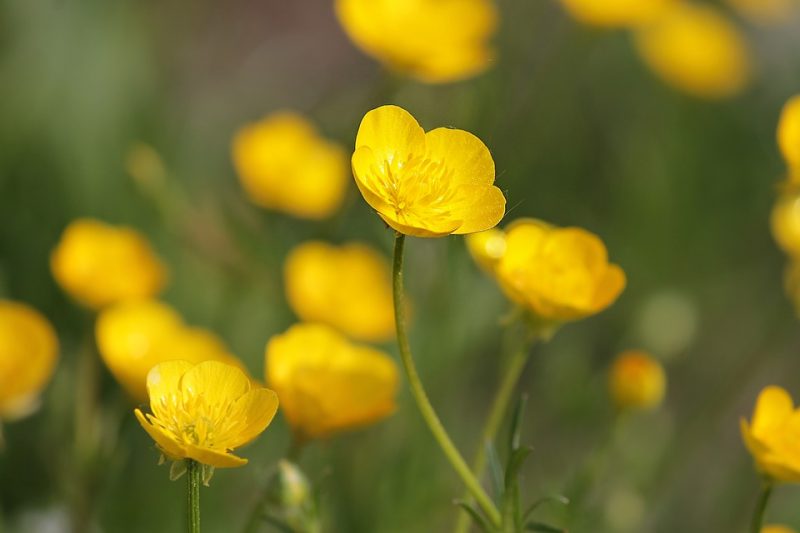
Buttercup flowers are species of plants found within the genus Ranunculus. Other types of flowers found within the genus include those referred to as water Crowfoots and spearworts. However, some people will use the term Buttercup to refer to all flowers of this genus. The petals of plants within the Ranunculus genus are frequently quite bright in coloration, often a visible bright yellow.
In addition, because of the coloration mechanism of the petals, the upper surface of the petal frequently has a mirrorlike sheen. This reflective surface causes a flashing when in the sun that helps regulate the temperature of the flower as well as attract pollinating insects. While buttercup flowers typically bloom during the spring months, they can often be found into the summer.
Let’s examine some more facts about the Buttercup flower, or Ranunculus genus, as well as take a look at some examples of flowers within this genus.
Buttercup Facts
The name of the Ranunculus genus comes from Latin, being a derivative of the word “rana”. It translates roughly to “little frog”. The name may have come from the fact that many Buttercup species grow along the banks of bodies of water. While some erroneously believe that buttercups are used to give butter its yellow coloration, this isn’t true.
Buttercups are somewhat toxic to livestock such as cattle, and for this reason, buttercups are often considered harmful weeds by livestock owners. Cattle will not typically eat Buttercups, doing so only if the field they are in is overgrazed and lacking in other forms of edible plant material. If ingested by cattle, symptoms such as excessive salivation, blistering of the mucous membrane, bloodied diarrhea, and other gastrointestinal issues can manifest themselves.
All of the species within the genus are toxic when they are consumed fresh. Consuming the Buttercup leaves an acrid taste in the mouth as well as blistering of the mucous membrane within the mouth. When the plants are handled by humans, a substance known as ranunculin is broken down to form protoanemonin. The toxin protoanemonin is released when the plant is wounded, and it can cause various dermatological issues when contacting the skin. Dermatitis, itch, rashes, and other painful symptoms can occur.
Buttercup flowers are typically perennial plants, meaning that they have lifespans of two years or more. Many other flowers are annual flowers or biannual flowers, having a year to two-year lifecycle respectively. However, some species of buttercups are biennial or annual.
Anatomy Of A Flower
The anatomy of a flower is made out of various structures such as the petal, the sepal, the peduncle, the receptacle, pistils, and stamens. Petals are what give flowers their unique shape. The bright coloration of the flower’s petals makes it attractive to insects and other creatures, which frequently help fertilize the ovules of the flower through pollination. The sepal of flowers are small structures that grow at the base of the petals. These small leaf structures help protect the flower before the petals bloom.
The peduncle of the flower is another term for the stalk or stem of a flower. The flower’s receptacle is the thick portion of the flower, found at the bottom of the flower where the head joins to the stalk. This structure contains the major organs of the flower.
Flowers can have female organs and male organs. The pistil is the female organ of the flower while the stamen is the male organ of the flower.
The pistil of a flower is made out of four parts. The ovules are the eggs of the flower, found within the ovary of the flower. The ovary of the flower is itself located at the base of the pistil. The ovary is responsible for holding the eggs that will be fertilized by the pollen of a male organ. When the eggs are fertilized, they begin growing and will eventually turn into a seed. Fruit plants not only create seeds but the fruit that surrounds the seeds as well. Much like the body of the flower itself, the pistil is split into a head and stalk. The stalk of the pistil is referred to as the style, while the head of the pistil is called the stigma. This stigma is what receives pollen, which kicks off the fertilization process. The style, meanwhile, helps protect the ovary from contamination, ensuring that only compatible pollen is able to flow through the pollen tube found in the style.
The stamen of the flower is the male organ, and it consists of a head and stalk. The head of the male organ is referred to as the anther, while the stalk of the male organ referred to as the filament. The anther creates pollen within it, and this pollen will be transported to the pistil of a flower by wind, animals, or insects. This is a necessary step in the reproduction of a flower. The filament is responsible for attaching the anther to the rest of the flower.
Many flowers have both male and female organs, while some flowers have only male organs or female organs, flowers with only one type of organ are called imperfect flowers while perfect flowers are flowers that have both a pistil and a stamen and are capable of reproducing on their own.
Buttercup Anatomy
Buttercups can be either terrestrial or aquatic plants, and they frequently have leaves in a rosette found at the stem’s base. Many perennial species of buttercups will create both new root-sets or new roots at roughly equally distanced nodes. The leaves of buttercup plants have stems and veins running through them, though they lack stipules. The leaf segments can be quite thin and fine, especially in aquatic species of buttercups.
Hermaphrodite buttercup flowers can be found either singly or within a cyme, but the most common arrangement for the flower is five green sepals surrounded by five white, green, or yellow petals, though these petals can sometimes be marked with purple, pink, or red. That said, the number of petals on an individual flower can vary rather dramatically, with the number occasionally be much higher. There is usually one nectary gland at the base of every panel, and this gland can be either covered by scales or naked. The flowers may have a few anthers, and these anthers can be arranged in a spiral formation. These anthers are often covered in yellow pollen. The buttercup flowers produce small achenes, tiny fruits, that can have spines, wings, or knobs on them. The achenes can also be smooth.
Types Of Buttercup Flowers
Creeping Buttercup
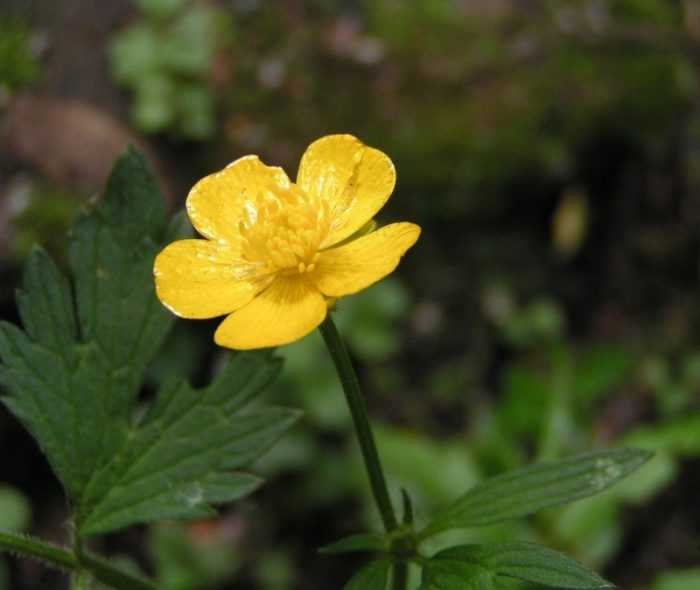
Photo: CC BY-SA 3.0, https://commons.wikimedia.org/w/index.php?curid=233686
The creeping Buttercup, Ranunculus repens, is found in Asia, Northwest Africa, and Europe. The creeping Buttercup can grow up to 50 cm tall, and it typically has five petals. The flower produces fruit in a cluster of achenes around 2/5 mm to 4mm long. The creeping Buttercup prefers moist soil, and therefore it is commonly found in flooded areas, ditches, and otherwise damp places. While once sold as an ornamental plant in many countries, its ubiquity and fast proliferation rate means that it is now considered an invasive species in many parts of the world.
Persian Buttercup
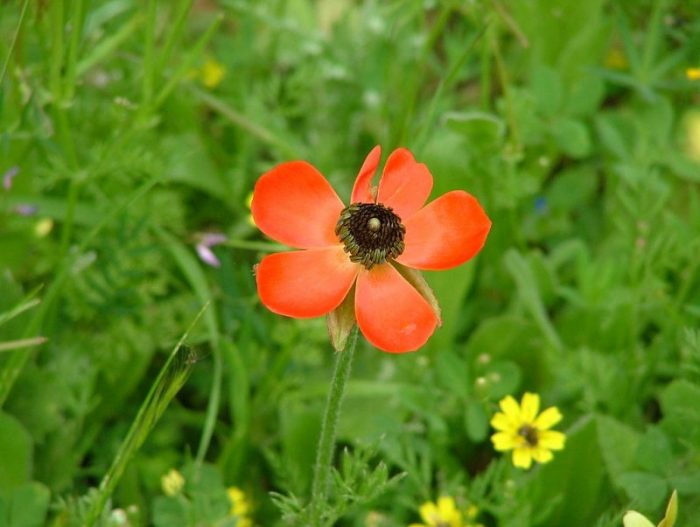
Photo: By SuperJew – Own work, CC BY-SA 3.0, https://commons.wikimedia.org/w/index.php?curid=25656013
The Persian Buttercup, scientific name Ranunculus asiaticus, is found in Western Asia, South Eastern Europe, northeastern Africa, and the Mediterranean region. The plant grows up to 45 cm tall, and it has small divided leaves near the base. Leaves found higher on the stem tend to be more deeply divided. The flowers themselves are usually 3 to 5 cm in diameter and can be white, yellow, or pink, or red. The Persian Buttercup is a popular ornamental plant, and some regions of the world, including some areas of Israel, list the plant as a protected species.
Glacier Buttercup
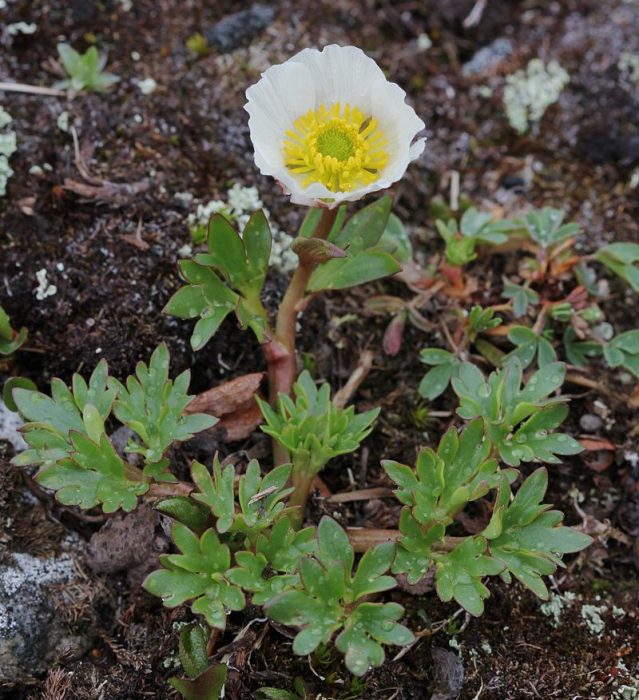
Photo: By Alinja – Own work, CC BY-SA 3.0, https://commons.wikimedia.org/w/index.php?curid=20524050
The glacier Buttercup is also known as the great glacier Crowfoot, scientific name Ranunculus glacialis. The glacier Buttercup is a specific Alpine/Arctic species of Buttercup, which can be found in cold environments such as the high mountains of Europe, Iceland, Greenland, the Barrow islands, and on the Scandinavian Peninsula. There are reports of glacier buttercups growing at altitudes of over 4000 m.
Sagebrush Buttercup
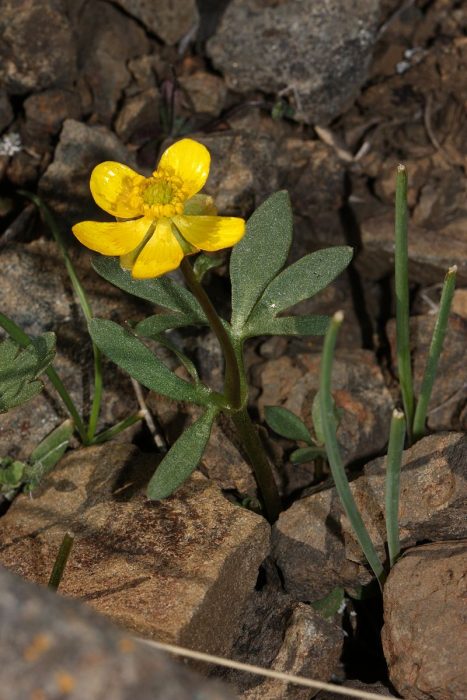
Photo: By Walter Siegmund (talk) – Own work, CC BY-SA 3.0, https://commons.wikimedia.org/w/index.php?curid=15529297
The Sagebrush Buttercup, scientific name Ranunculus glaberrimus, is a type of Buttercup they can be found across the western United States, Western Canada, Midwestern North America, and the Northwestern Great Plains. The sagebrush Buttercup can be found at fairly high altitudes, sharing habitat with big sagebrush and Juniper in areas like the Rocky Mountains and great basin. The sagebrush Buttercup is approximately 4 to 15 cm tall and has between 5 to 10 yellow petals around 1 1/2 cm long.
Straightbeak Buttercup
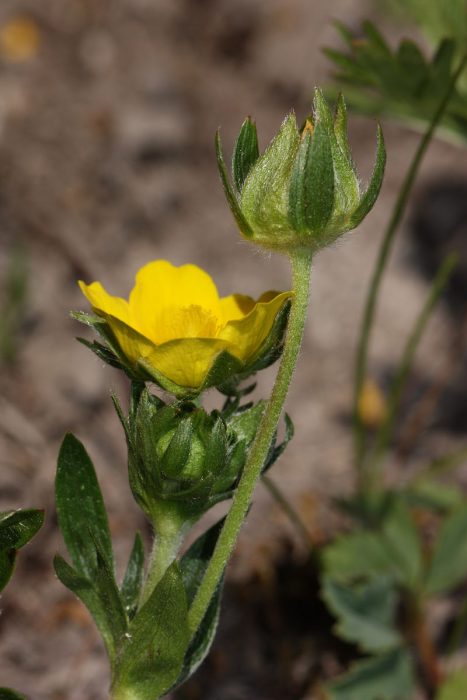
Photo: By Walter Siegmund (talk) – Own work, CC BY-SA 3.0, https://commons.wikimedia.org/w/index.php?curid=35974842
The straightbeak Buttercup, Ranunculus orthorhynchus, is a species of Buttercup native to the western half of North America in states such as Utah, California, and Alaska. The straightbeak Buttercup prefers areas with high moisture, though it can grow in various types of habitats such as marshes and meadows. It has more petals than the average Buttercup, typically having around eight petals each between 1 to 2 cm in length. The fruit that the achene bears is born in a spherical formation.









